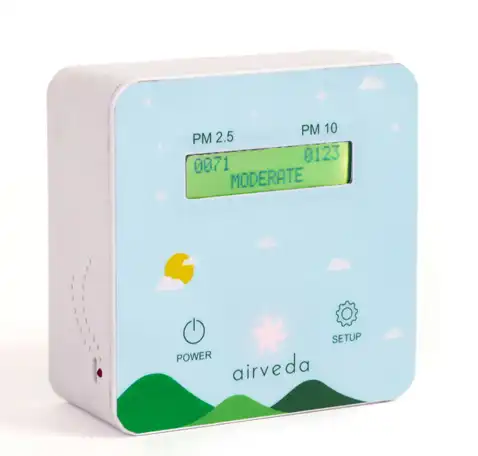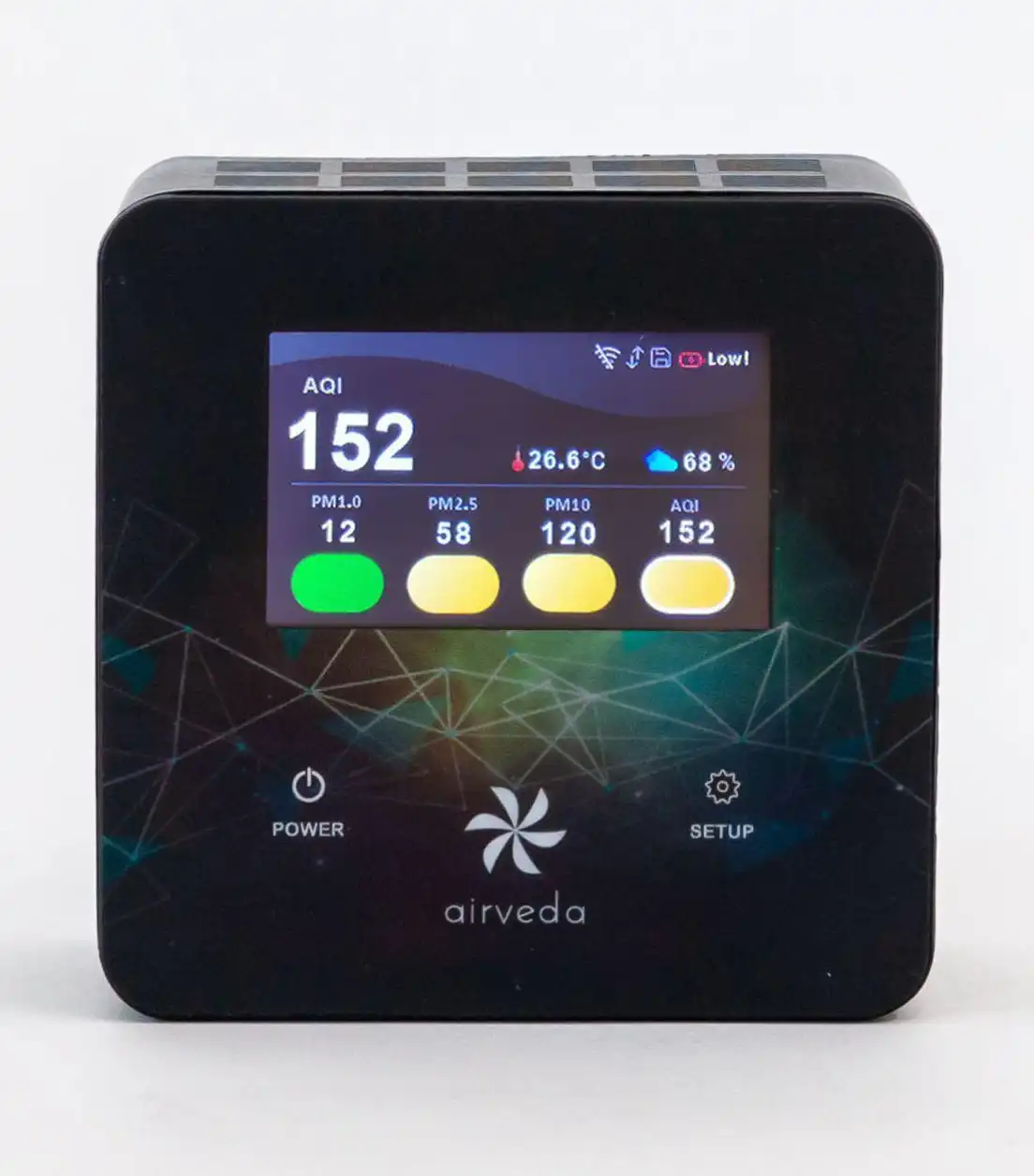Air Quality in Your Home - Myths Around Air Quality Monitoring Busted
Poor Indoor Air Quality (IAQ) is a health hazard to the occupants in any kind of enclosed space. How do you fix something that you cannot measure? Hence, the constant monitoring of air quality in our homes is essential. Despite this fact, we are faced with several misconceptions around it that we might end up believing.
Read on as we try to bust some of the myths surrounding air quality monitoring:
1. Indoor air is clean. Air pollution is an outdoor problem.

Whenever we think of air pollution, we imagine toxic vehicle exhausts or factory fumes expelling gray smoke. However, indoor air pollution is just as lethal as its outdoor counterpart. Maybe, even more. Many factors that are responsible for deteriorating air quality around us are found inside our abodes. From fresh paint to cleansers, disinfectants, room freshners, furnishings and varnishes, the air we breathe indoors is often more toxic than outdoor air.
We tend to think that staying indoors on poor air quality days is good enough but actually indoor air quality is only 10-20% better than outdoor air quality on poor air quality days and sometimes can be worse than outdoors.
Some of the pollutants that you should be aware about are:
-
Particulate matter: While larger pollutants are easily visible to the eye, particulate matter, a mixture of very tiny solid and liquid particles is not. They can get into the respiratory tract, penetrate deep into the lungs and even into the bloodstream causing severe health damage.
Indoor PM is primarily as a result of the outdoor air leaking into the indoors, but can also be generated indoors through cooking, combustion activities (including burning of candles, use of fireplaces, use of unvented space heaters or kerosene heaters, cigarette smoking) and dusting. Because it is invisible to the eye, the only way to know if your indoor space is polluted is using a PM2.5 air quality monitor.
PM2.5 is the sixth highest risk factor for death around the world, claiming more than 4 million lives annually, according to recent global morbidity data. Add in household pollutants from indoor cooking fires and other combustion sources, and the tally approaches 7 million lives lost each year.
-
CO2: Carbon dioxide (CO2) is a byproduct of combustion, as well as a result of the metabolic process in living organisms. Exposure to carbon dioxide can lead to certain serious health effects, including headaches, dizziness, restlessness, difficulty in breathing, sweating, tiredness, and increased heart rate. Your body is the most significant source of indoor carbon dioxide. Other sources of CO2 in your homes are conventional open flames in your home - gas or wood stoves, fireplaces, and candles, cigarettes. In some cases, the soil under your home may also release dangerous amounts of CO2.
As per a report, CO2 levels would need to reach a very high concentration of at least 5,000 parts per million (ppm) before they would affect human health. At higher levels, about 2500 ppm, CO2 can make you sleepy and tired, slow down your brain, and even give you a slight headache. But a growing body of research suggests CO2 levels as low as 1,000ppm could cause health problems, even if exposure only lasts for a few hours.
A study by the Harvard Chan School of Public Health finds that there is a direct and negative impact of CO2 on our cognition and decision making skills. They found that on average, a typical participants' cognitive scores dropped 21% with a 400 ppm increase in CO2.
-
Volatile organic compounds (VOC) are organic chemicals which have low boiling points and thus they evaporate and mix into the air very easily. Total volatile organic compounds (TVOC) is a group of VOCs used to represent the entire pool of pollutants.
Volatile organic compounds can come from an array of sources, including human-made and natural sources. Because manufacturers utilize VOCs as inorganic solvents, the majority of indoor VOCs come from everyday household staples, including paints and solvents, cleaners and disinfectants, pesticides and air fresheners.
As per a study conducted by BreatheEasy Consultants, which monitored air quality in over 400 Delhi-NCR homes, found that the concentration of Total Volatile Organic Compounds (TVOC) in many residences surpassed 1000 μg/m3, exceeding the safe limit of 200 μg/m3.
Read: VOCs (Volatile Organic Compounds) lurking in every home and how its affecting our health
Monitoring air quality can help you understand what activities indoors are leading to poor air pollution so that you can stop these.
2. I don't need a monitor. I have filled my house with Indoor plants.

A lot of people fill their house with indoor plants thinking that they work in improving the indoor air quality. But most indoor plants only help in removing VOCs and CO2, and that too to a very little extent.
Researchers from Drexel University in the US claimed that previous studies have vastly exaggerated the ability of indoor plants in removing volatile organic compounds.
“This has been a common misconception for some time. Plants are great, but they don’t actually clean indoor air quickly enough to have an effect on the air quality of your home or office environment,” said Michael Waring, an associate professor at Drexel’s College of Engineering, in a statement.
3. I don’t need a monitor. I already bought a purifier - my house is clean.

A lot of people buy a purifier and think that they’ve done their bit to protect their family from air pollution.
Moreover, not every air purifier is equipped to work for your space. Having a monitor helps you understand if the purifier is effective for your room which may vary based on room-size, amount of leakage etc. Effectiveness will also depend on season - you may find a purifier that is effective in the summer but not in the winter - monitoring regularly is the only way to ensure that your purifier continues to be effective and protects your family’s health.
Purifiers also require filter changes regularly. The only real way to know if the purifier needs filter changes is when the number on the monitor stops coming down even when the purifier is running. Many people keep running the purifier not realizing that it is actually not just ineffective, but gathering dust and viruses on the filter putting their family’s health at further risk.
4. I don’t need a monitor. My purifier has a PM2.5 indicator on it.

A lot of people check the air quality numbers on purifiers but here’s why this approach is wrong:
As stressed earlier, people who don't have a monitor won't even turn on their purifier most of the year, so the indicator is really no use. First, yYou need a monitor firsty to know when to turn your purifier on.
The air near the purifier cleans up quickly - so the number on the purifier is not what you are breathing. What is worse, is that often this number is used to auto-control the speed the purifier runs on, which again is based on the incorrect assumption that the room is clean, even though only the air around the purifier has been cleaned
Purifier companies use poor quality sensors to keep the prices low since the purifier needs to be competitive in the market. A lot of science goes into calibrating sensors which needs to be done seasonally, plus sensors need to be replaced once a year due to drift and life of the sensorof sensor, but purifier manufacturers mostly ignore these details.
Finally the monitor in the purifier is not portable. You can’t take it to the balcony to measure air quality outdoors or to your kids' schoolkids school to check air quality there. Infact, often people have multiple purifiers in each room, so they end up paying for 6 sensors instead of requiring one for their house.
5. Outdoor monitors can only be Government monitors. I have no choice if a Government monitor is not set up close to my house.

As low cost monitoring and sensors are becoming more and more accurate, various Governments around the world are investing in low cost monitoring to ensure that more areas are covered under monitoring. You can sponsor an outdoor monitor in your neighborhood or apartment complex, set it up conveniently in your balcony and make it public on the Airveda app at a very affordable price. This will ensure that you can know the air quality in your condominium and where your child is playing to ensure you are sending the kids outside when the air is relatively cleaner
Here are some suggested Air Quality Monitors for your home:
Airveda PM2.5, PM10 Monitor White
(PM2510P)

The Airveda PM Air Quality Monitor Pro accurately measures PM2.5 and PM10, providing real-time data on particulate matter levels in your home. It has a led indicator which turns green, yellow, or red based on current data ensuring you can quickly tell the air quality in your home from afar.
The device connects to your Wi-Fi and shows data in your mobile app on both iOS and android enabling you to get notifications and track the data remotely.
You can set up your device to turn off the display at night hence giving you undisturbed sleep at night when placed in a bedroom.
It's an essential device for ensuring clean indoor air and managing indoor air pollution effectively.
Airveda PM Temperature Humidity Air Quality Monitor
(PM12510TH-T)

In addition to all the features of the above model, this monitor offers a comprehensive view of your indoor air quality by measuring PM1.0, temperature, and humidity levels. It has a 3.5 inch touch screen which allows you to view your data from afar conveniently. Each parameter will show a green, yellow or red bullet based on limits which you can customize using the app. It also allows you to select a particular parameter which you wish to highlight and view easily from afar. It is suitable for a range of environments, providing valuable insights into the overall air quality and comfort of your indoor spaces.
Airveda PM CO2 Temperature Humidity Air Quality Monitor

This monitor adds support for CO2 in addition to PM2.5, PM10, Temp and humidity. CO2 levels in your bedroom reach extremely high levels at night and tracking and managing this is essential to get a good night sleep. Learn more about why measuring CO2 is important.
Here we have 2 models PM2510CTH which provides all these parameters with a 2 line LCD version and PM2510CTH-T which comes with a beautiful touch screen.
Using the Airveda App for enhanced monitoring
By pairing these monitors with the Airveda app, you can easily keep track of both indoor and outdoor data at all times. The Airveda app will show you data not just from your monitor but also from 9000 stations around the world including all Government and many Airveda monitors installed across the country. This enables you to track outdoor air to know when to enjoy a clean day outdoors and when to make sure you go out with a mask. You can also track the indoor data remotely enabling you to always ensure that your loved ones are breathing clean air at home no matter where you are.
Download our Android and IOS App now
If you wish to learn more about which air quality monitor is right for you feel free to get in touch with us at info@airveda.com

